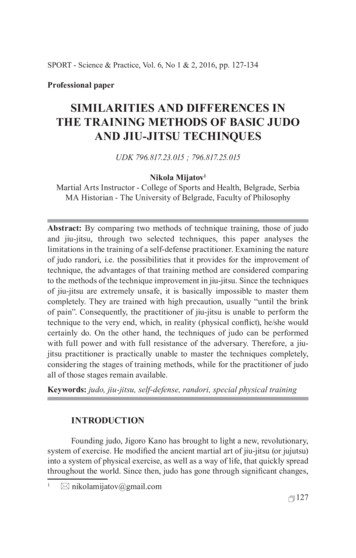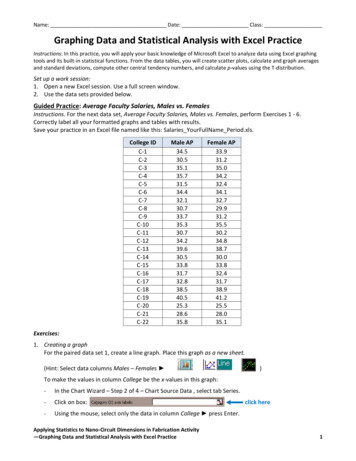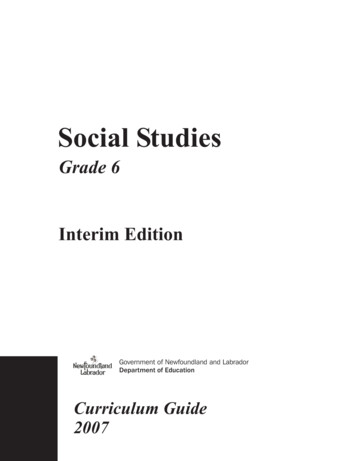
Transcription
SPORT - Science & Practice, Vol. 6, No 1 & 2, 2016, pp. 127-134Professional paperSIMILARITIES AND DIFFERENCES INTHE TRAINING METHODS OF BASIC JUDOAND JIU-JITSU TECHINQUESUDK 796.817.23.015 ; 796.817.25.015Nikola Mijatov1Martial Arts Instructor - College of Sports and Health, Belgrade, SerbiaMA Historian - The University of Belgrade, Faculty of PhilosophyAbstract: By comparing two methods of technique training, those of judoand jiu-jitsu, through two selected techniques, this paper analyses thelimitations in the training of a self-defense practitioner. Examining the natureof judo randori, i.e. the possibilities that it provides for the improvement oftechnique, the advantages of that training method are considered comparingto the methods of the technique improvement in jiu-jitsu. Since the techniquesof jiu-jitsu are extremely unsafe, it is basically impossible to master themcompletely. They are trained with high precaution, usually “until the brinkof pain”. Consequently, the practitioner of jiu-jitsu is unable to perform thetechnique to the very end, which, in reality (physical conflict), he/she wouldcertainly do. On the other hand, the techniques of judo can be performedwith full power and with full resistance of the adversary. Therefore, a jiujitsu practitioner is practically unable to master the techniques completely,considering the stages of training methods, while for the practitioner of judoall of those stages remain available.Keywords: judo, jiu-jitsu, self-defense, randori, special physical trainingINTRODUCTIONFounding judo, Jigoro Kano has brought to light a new, revolutionary,system of exercise. He modified the ancient martial art of jiu-jitsu (or jujutsu)into a system of physical exercise, as well as a way of life, that quickly spreadthroughout the world. Since then, judo has gone through significant changes,1 nikolamijatov@gmail.com 127
SPORT - Science & Practice, Vol. 6, No 1 & 2, 2016surely the most important one being the predominance of its sports aspectwhen it became an Olympic sport in Tokyo in 1964.Despite becoming an elite sport, judo remained a marital art. Eventhough the two terms are often mixed, the difference is important. Martialarts lack competitive aspect, they are strictly focused on the mastering oftechniques, acquiring grades of belts and their unique philosophy. As such,aikido and nin-jutsu stand out. On the other hand, combat sports are focusedsolely on competitions, like boxing or wrestling. Judo, taekwondo and karatein their essence have both aspects: martial art as well as sport. The question ishow much did the sports transformation take away from judo as a martial art,and whether it still has significant implementation in physical confrontation(outside sports battleground).For a deeper understanding, we should take a look at the historicaldevelopment of judo and jiu-jitsu. Medieval Japan was dominated by thewarrior class of samurais, who dedicated their whole lives to serving theirfeudal masters, i.e. daimyo (Kliri, 2006). For that purpose they practicedmartial arts daily. The most common one was the art of fighting with asword – kenjutsu. In case of losing the sword in a battle, they practiced anadditional martial art of jiu-jitsu, an art that does not involve weapons forthe most part. Since its key role was on the battlefields, the very techniquesof jiu-jitsu were extremely brutal and usually resulted in the death of theadversary.The change came with the Meiji restoration, which completelytransformed the Japanese society in order to catch up with the course ofmodernism, practiced by the imperial powers (Stojanović, 2015). One of thefirst acts of reform was the sword carrying ban, which resulted in the thriveof jiu-jitsu that then became a dominant martial art. However, in the modernJapanese society there was no room for the deadly techniques of jiu-jitsu,and the martial art itself had its reformer – Jigoro Kano. He conducted astrict selection of techniques and incorporated only the ones that were safefor both practitioners into his own martial art - judo. Another importantaction is that he was the first to include physical exercise in a martial art,since he was aware of the significance of sport in the modern society (Kano,2007). The distinction is obvious in the name itself. While the suffix “jitsu”stands for a martial art that is adjustable and aimed at practical use, Kanouses the term “do”, thus creating judo. The very term “do” implies that thepurpose of the martial art is in a profound, philosophical sense (De Majo,2010).Today, in judo, randori dominates as a consequence of the sportsaspect of the art. In it, within the limits of precisely defined rules, varioustechniques are allowed, but many are forbidden as well. In this paper, theemphasis is on the allowed techniques, the possibilities of their use within128
N. Mijatov: SIMILARITIES AND DIFFERENCES INTHE TRAINING METHODS OF BASIC JUDO AND JIU-JITSU TECHINQUESrandori and the effects which such technique training can produce. Althoughbelonging to the sports aspect, those are also self-defense techniques thatcan be found in a wide range of jiu-jitsu techniques (as a representative selfdefense martial art) (Mudrić, 2005; Nešić, Radoš, 2002; Vukelić, 2004). Byanalyzing the training process laws, the dominant mastering of techniques,as well as the nature of self-defense techniques, we will try to perceive therole that practicing judo randori can play in the process of mastering selfdefense techniques.On the other hand, jiu-jitsu itself is taking the sports path. Namely,its sports aspect has been formed by means of a strict selection of thetechniques of this previously exclusively martial art. Unlike judo, these fightsare characterized by a far greater number of allowed techniques as well asthe usage of techniques other than throwing and ground fighting, which arecharacteristic for judo. Nevertheless, in this paper the focus will be on the stilldominant self-defense aspect of jiu-jitsu and on the technique that is bannedfrom its sports combat version.1. THE THEORETICAL BASIS OF THE PAPERIn a physical conflict between two individuals there are, roughlyspeaking, 4 distances. First, the distance of strikes where leg kicks and armpunches are dominant, especially at a distance, like Mawashi geri in karate.Next is the clinch distance where punches and kicks with arms, elbowsand knees are common. Following this distance and for the paper the mostimportant one, is the grappling distance in which the adversaries maintain agrapple and aim to knock down the adversary. As a consequence there is alsothe final floor distance, which is also included in judo, yet for self-defense itis not of great significance. This is due to the possibility of multiple attackers’attacks, in which situation, engaging in floor fight to disengage one of themcould prove fatal.The third, grappling distance is the subject of this paper. In it, theclothes or the body have been grabbed, it is essential to knock the opponentdown to the ground. The same principle is also the key feature of judorandori, shaped by the long-standing experience and the demands of theInternational Olympic Committee. It is known becoming an Olympic sportrequires compliance with stringent security standards prescribed by the IOC.Judo began its own evolution from a martial art to an Olympic sport withthe introduction of “physical education” in judo training by Jigoro Kano(Kano, 2007). As a consequence, rules are strict and equal everywhere inthe world where judo is practiced. For the topic of the paper, the corpus ofallowed techniques is crucial, as well as the way they are conducted duringthe fight. Also, these distances are also trained in self-defense in order to 129
SPORT - Science & Practice, Vol. 6, No 1 & 2, 2016make fighter’s skill set complete. Jiu-jitsu itself relies on judo throwingtechniques in the grappling distance, using them to successfully overcomesuch distance - de facto to throw the adversary. Therefore, a practitioner ofjiu-jitsu is not unfamiliar with judo throws, but rather exercises them in everytraining session.Judo randori permits 38 basic throws and their numerous variations(Kudo, 1969). The nature of the performance of these throws, which is veryclose to an actual physical conflict between two adversaries, is significant tous: the throw is performed with the maximal use of force and, on the otherhand, with the maximal resistance of the adversary.This characteristic cannot be found among self-defense techniques,i.e. the jiu-jitsu techniques. Those techniques are practiced in strictly limitedconditions, using an almost experimental method, which will be covered laterin this paper.We will regard these two characteristics as crucial and analyze themthrough the laws of the training process in the field of learning and masteringtechnique. The methodology of technique learning, according to Stefanovićand Jakovljević (2004) consists of V stages:I stage: technique learning – conducted under facilitated conditionsII stage: technique mastering – conducted under harder conditionsIII stage: the creation of style – upgrading the existing, acquiredtechniquesIV stage: the creation of a specialty – forming a specific technicaldetailV stage: the creation of a new technique variation – the highest formof creativityUnlike in sport, in martial arts the focus is on the first two stages,because of the broad field of self-defense. While in sport the fight is limited bythe rules, in an actual conflict between two adversaries everything is allowed,with the only potential limitations being moral norms.In order to successfully complete the given stages of techniquelearning, Stefanović and Jakovljević (2004) also define three phases:I phase: basic technique learning under facilitated conditionsII phase: mastering the technique under normal training conditionsIII phase: a situational technique training under competitive conditionsThe first two phases are available both in judo and jiu-jitsu. The problemis in the third phase, which is in judo represented in the form of randori. Thequestion of the realization of that phase in jiu-jitsu, i.e. the mastering of selfdefense, and the possibility of its realization in judo is the framework of thispaper.As a self-defense technique, i.e. jiu-jitsu, the “Double block with hands,over-the-shoulder elbow lock” will be analyzed. Its methodology is described130
N. Mijatov: SIMILARITIES AND DIFFERENCES INTHE TRAINING METHODS OF BASIC JUDO AND JIU-JITSU TECHINQUESin one of the rare practical books related only to jiu-jitsu: Nešić and Radoš(2002). The technique itself is displayed on Picture 1.Picture 1. Double block with hands, over-the-shoulder elbow lockThe key feature of this, and many other jiu-jitsu techniques, is thatwhen fully performed, especially in the third phase, it ends up breaking theadversary’s arm in the area of elbow joint. Because of that it is extremelyefficient but also dangerous to practice; due to this, it is usually practiced tothe brink of pain, i.e. until the adversary surrenders because of the lock.On the other hand, the judo technique we will analyze is the basic legthrow: Osoto-gari. The explanation of this technique (Picture 2), is found inthe work of Kudo (1969).Picture 2. Osoto-gariJust like other judo throws, the technique is safe for the adversary.If performed on tatami, and if the adversary is familiar with the falling 131
SPORT - Science & Practice, Vol. 6, No 1 & 2, 2016techniques, the very performance of the technique involves no major dangersto practitioners. As such, Osoto-gari is a part of judo’s competitive techniques.By analyzing these two basic techniques, we will consider the (im)possibilities of their practicing in those phases, and by doing so perceive thesignificant differences that emerge in the methodology of technique masteringin judo and jiu-jitsu.2. T HE ISSUES IN THE PROCESS OF LEARNING ANDMASTERING TECHNIQUESThe displayed technique of jiu-jitsu “Double block with hands, overthe-shoulder elbow lock” can certainly be practiced in the first two phases:basic technique learning under facilitated conditions and mastering thetechnique under normal training conditions. The issue arises in the thirdphase: the situational technique training under competitive conditions.For the art of self-defense, competitive conditions represent an actual,maximum intensity confrontation between two adversaries. What is notable isthat if the given technique was conducted in such circumstances, the adversarywould suffer a serious elbow injury. Consequently, the technique itself is neverpracticed through that method, but in strictly limited conditions. In the processof training, the adversary (or in the process of practicing the technique, thepartner) in jiu-jitsu must not offer significant resistance. He/she must cooperatewith the attacker in order to conduct the technique safely. Due to this apractitioner of jiu-jitsu is not capable of performing the technique to the veryend, far away from “competitive conditions”, i.e. an actual physical conflict.On the other hand, Osoto-gari can be conducted in full intensitywithout major consequences for the practitioner, provided that the techniqueis performed on tatami and that the partner has mastered the falling technique.In addition, the competitive conditions in judo are found in randori, in whichthe technique can be fully tested.As a consequence of the radically different conditions of techniquemastering, we have radically different approaches to its training.In jiu-jitsu the issue with technique mastering is a, surely necessary,limit: “to the brink of pain”. To avoid the technique performance to causeinjuries to the partner, a practitioner of jiu-jitsu is not capable to perform thetechnique to the end, unless in an actual physical conflict. This is a significantdrawback in the process of learning and mastering the technique.On the other hand, in judo, randori, a practitioner is able to performthe technique with adversary’s full resistance and know for sure that theyhave mastered the technique. Bu successfully performing a throw in randori,judoka is certain that they have master the technique, i.e. that they passed allthe aforementioned stages of technique learning.132
N. Mijatov: SIMILARITIES AND DIFFERENCES INTHE TRAINING METHODS OF BASIC JUDO AND JIU-JITSU TECHINQUESA practitioner of jiu-jitsu cannot have that certainty, unless he has anexperience from a real physical conflict. Experts tried to solve this methodologicalproblem of jiu-jitsu in different ways. For example, Nešić and Radoš (2002), aswell as Mudrić (2005), recommend combinations of techniques which wouldcover a wide range of possible physical conflicts between two individuals.This would lead to the mastering of certain technical elements, but not entiretechniques, thus enabling the practitioner to overcome the situation. From theaspect of special physical training (the training of the army and police SpecialForces), Vukelić (2004), aware of the danger that full intensity practicing ofjiu-jitsu involves, nevertheless recommends: “harder, and even risky conditionsfor beginners”. It is important to bear in mind that the stated methodology isrecommended only for special forces, because “a poorly mastered techniquecould cost a member of special forces his/her life“. Implementing the sameapproach in case of practicing jiu-jitsu as a civilian is out of question.Consequently, third phase of technique mastering (a situationaltraining in competitive conditions) in judo randori is almost completely safe.Even the later stages of technique learning (the creation of style, the creationof a specialty and the creation of a new technique variation) can achieve theirfull swing precisely in randori. In jiu-jitsu, except in special physical training,those stages for a practitioner remain within a practitioner’s reach, and thetechnique itself is never fully mastered.CONCLUSIONThe comparative analysis of two techniques “Double block with hands,over-the-shoulder elbow lock” and Osoto-gari, first and foremost showssignificant differences in the methodology of learning those techniques.While it is possible to master Osoto-gari, with the self-defense technique thefinal stages of the learning process remain unattainable.Thereby in the self-defense techniques of jiu-jitsu, through the analyzed“Double block with hands, over-the-shoulder elbow lock” a significantmethodological problem is noticeable. The practitioner is unable to fully learnthe technique, i.e. master all the stages of its learning, which leads to thequestioning of the real usage of this very technique. On the other hand, itis possible to master the judo technique – Osoto-gari by completing all thestages of technique learning, and even form a specific personal style.Theoretically, the jiu-jitsu technique is undoubtedly more realistic andmore applicable in an actual physical conflict. Osoto-gari can also be usefulin a physical conflict. Yet, as a throwing technique it has a major drawback:there is no overcoming the punching distance, but the technique begins atthe grappling distance. From that point of view, the jiu-jitsu technique isclearly superior, particularly having in mind that Osoto-gari was formed for 133
SPORT - Science & Practice, Vol. 6, No 1 & 2, 2016a sports confrontation and not for a physical conflict. However, the questionof the actual applicability of the jiu-jitsu technique outside the “experimental”conditions at the very training remains open, while the technique of judo canbe mastered to perfection.REFERENCES1.2.3.4.5.6.7.8.9.De Majo, A. (2010). Budo: put drevne mudrosti: izabrani tekstovi.Beograd: Bibliografsko izdanje.Kano, Đ. (2007). Put mekoće. Beograd: Liber.Kliri, T. (2006). Bušido – kodeks samuraja. Beograd: Babun.Kudo, K. (1969). Judo: tehnika bacanja. Zagreb: Mladost.Mudrić, R. (2005). Specijalno fizičko obrazovanje: priručnik. Beograd:Viša škola unutrašnjih poslova.Nešić, М. i Radoš, Ј. (2002). Veština samoodbrane: ju-jutsu. BačkaPalanka: Sportska asocijacija grada.Stefanović, Đ. i Jakovljević, S. (2004). Tehnologija sportskog treninga.Beograd: Fakultet sporta i fizičkog vaspitanja.Stojanović, D. (2015). Rađanje globalnog sveta 1880–2015: vanevropskisvet u savremenom dobu. Beograd: Udruženje za društvenu istoriju.Vukelić, M. (2004). Specijalno fizičko vežbanje. Beograd: SIA.134
The first two phases are available both in judo and jiu-jitsu. The problem is in the third phase, which is in judo represented in the form of randori. The question of the realization of that phase in jiu-jitsu, i.e. the mastering of self-defense, and the possibility o











